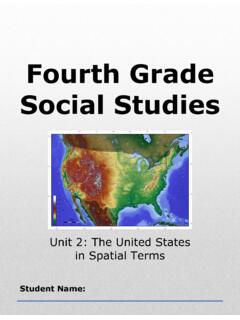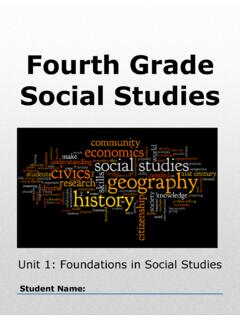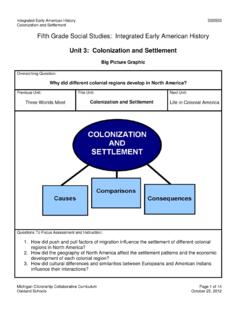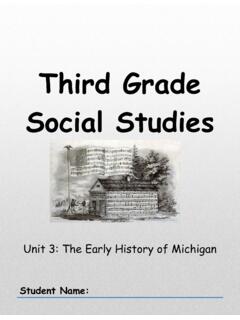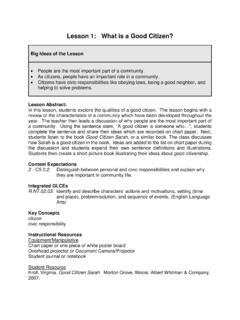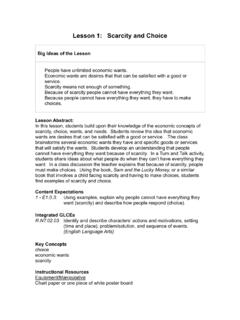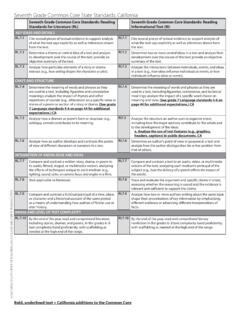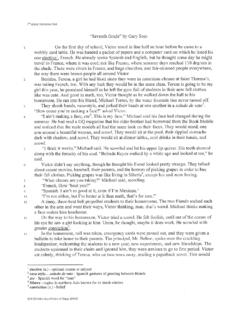Transcription of Seventh Grade Social Studies: Ancient World History
1 7th Grade Social studies SS0702 Unit 2: Beginnings of Human Societies Michigan Citizenship Collaborative Curriculum Page 1 of 12 Copyright 2010-2015 by Oakland Schools July 13, 2015 Seventh Grade Social studies : Ancient World History Unit 2: Beginnings of Human Societies Big Picture Graphic Overarching Question: How can we know about the past? Previous Unit: An Introduction to World History This Unit: Beginnings of Human Societies Next Unit: Early Civilizations and Pastoral Peoples Questions To Focus Assessment and Instruction: 1. How do we learn about humans and human ancestors in pre-historic times, before there was writing? 2. How and why did humanity spread across the earth? 3. How did the natural environment shape the ways people lived in the Paleolithic Era? 4. How and why did many humans begin to shift from full-time foraging to living in settled villages?
2 Types of Thinking Evidentiary Argument Compare and Contrast Cause and Effect Description Predicting 7th Grade Social studies SS0702 Unit 2: Beginnings of Human Societies Michigan Citizenship Collaborative Curriculum Page 2 of 12 Copyright 2010-2015 by Oakland Schools July 13, 2015 Graphic Organizer 7th Grade Social studies SS0702 Unit 2: Beginnings of Human Societies Michigan Citizenship Collaborative Curriculum Page 3 of 12 Copyright 2010-2015 by Oakland Schools July 13, 2015 High School Foundations (see World History and Geography) F1: World Historical and Geographical Habits of Mind and Central Concepts: Explain and use key conceptual devices World historians/geographers use to organize the past including periodization schemes ( , major turning points, different cultural and religious calendars), and different spatial frames ( , global, interregional, and regional).
3 F2: Systems of Human Organizations: Use the examples below to explain the basic features and differences between hunter-gatherer societies, pastoral nomads, civilizations, and empires, focusing upon the differences in their political, economic and Social systems, and their changing interactions with the environment. o Changes brought on by the Agriculture Revolution including the environmental impact of settlements. Historical Overview The universe is 13 billion years old and the earth is probably between four and five billion years old. However, modern humans are relatively new to the planet, having emerged through the processes of evolution between 200 and 300 thousand years ago. Learning about humans and their ancestors that far back in the past is difficult, yet archaeologists and anthropologists have found and analyzed fossils, tools, and other artifacts our ancestors left behind in order to understand the origins of modern humans.
4 Hominids1 developed somewhere between two and three million years ago in Africa, and they evolved over hundreds of thousands of years. Hominids are characterized by an upright gait, increased brain size and intelligence relative to other primates, a flattened face, and smaller sized teeth and jaw. Within the family Hominidae, scientists include Australopithecus, Homo erectus, and Homo sapiens (modern humans). Sometime between 125,000 and 60,000 years ago, humans began to migrate out of east Africa into other parts of the World . This migration took thousands and thousands of years, and as humans migrated, they learned to live in more varied environments such as deserts and dense forests. Humans migrated to new biomes to find food, escape weather patterns, and find space for a growing population.
5 Current evidence indicates that language might have developed in Africa, anywhere between 50,000 and 100,000 years ago. As humans migrated and moved, language likely became more complex and helped people solve new problems. Spreading out across the globe, developing language and tool use, these humans lived as foragers, often moving to find and follow food sources. The quality of life for foragers was dependent on environmental factors like climate, vegetation, and available game for hunting. They most likely traveled in family-based groups. By studying the artifacts they left behind, from bones and tools to artwork and dwellings, archaeologists and historians have come to understand some characteristics of Paleolithic societies. The end of the Paleolithic Era coincided with the last Ice Age.
6 By this time, humans had spread across most of the Earth. The end of the last Ice Age is known as the Great Thaw, occurring about 10,000 years ago, and it generated warmer, wetter, and more productive climates. These changes marked one of the major turning points in human History , a gradual shift from a time when all humans 1 The term hominid refers to any of the modern or extinct bipedal primates of the family Hominidae, including all species of the genera Homo and Australopithecus. 7th Grade Social studies SS0702 Unit 2: Beginnings of Human Societies Michigan Citizenship Collaborative Curriculum Page 4 of 12 Copyright 2010-2015 by Oakland Schools July 13, 2015 gathered their food (foraging) to one in which most humans produced their food (agriculture). Notably, settled agriculture appeared independently in several different regions of the World that were well-suited for farming because of environmental factors and population patterns.
7 However, some groups remained foragers (in fact foragers still exist today). Farming allowed people to develop food surpluses and changes in technology allowed people to store food. These developments permitted population growth and resulted in the settlement of denser populations. Food surpluses and larger populations enabled people to specialize because not everyone had to put their energy into food production. This spawned the development of new types of jobs in these agrarian, village-based societies. New problems emerged as people lived in larger groups in settled villages. Social institutions changed and developed to respond to these changes and to address these new problems. Despite many differences, there were important similarities across early human settlements even though they were not in contact with each other.
8 These similarities suggest independent development of similar forms of agriculture, specialization, and Social structures. Global patterns of early human development were characterized by settled villages with greater numbers of people near important natural resources, growing dependence on agriculture and animal domestication, the development of Social institutions and culture ( burials, art and architecture, etc.), and the specialization of labor. Unit Abstract This unit introduces students to the disciplines of anthropology and archaeology in the context of studying human origins and prehistoric human societies. Students begin with a literacy-rich lesson in which they are introduced to the importance of metacognition being aware of one s thinking. Students explore a variety of concrete reading comprehension skills and practice making their thinking visible through a Think-Aloud reading strategy.
9 They then begin their study of prehistory by examining the larger chronology of the universe, the earth, and human History in order to help them conceptualize time and chronology. Students explore the different types of evidence these scientists use to learn about humans in the distant past and make their own conjectures and conclusions in the process. Students also learn about evolution and the broad scope of human History from early hominids up to the Neolithic Revolution. They study the important role that human/environment interaction played in shaping early human societies, and explore the push/pull factors of early human migration. In exploring movement and migration, students consider the role of language development and communication in problem solving. Students then examine artifacts of tool use and early human homes to explore how humans adapted to their environment.
10 Towards the end of the unit, students explore the Agricultural (Neolithic) Revolution, looking in particular at the development of different crops around the World and exploring archaeological work in different Neolithic villages. They explore the Neolithic Revolution as a turning point and consider the historical theme of continuity and change by comparing life during the Era of Foragers with the Agrarian Era. An important thread in this unit is that the development of human societies across the World was a long, gradual process. The Neolithic Revolution, for example, did not represent a conscious choice by people around the World to start farming and stop hunting, but rather was the result of gradual changes and human learning over time. Throughout the unit, students read and analyze a range of texts. These integrated reading activities are designed to scaffold and support students analysis and higher-ordered thinking with texts in order to meet the demands of the Common Core Literacy Standards.
